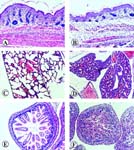Phenotypes associated with this allele
|
|
| Find Mice |
Using the International Mouse Strain Resource (IMSR)
Mouse lines carrying:
Ptpn11tm1Paw mutation
(0 available);
any
Ptpn11 mutation
(43 available)
|
|
|
cellular
|
|
• cultured trophoblast stem cells exhibit an increase in ploidy under differentiating conditions
|
|
|
• null trophoblast stem cells die rapidly in culture
|
|
|
• mutation causes decreased trophoblast stem cell proliferation and colony formation in culture
|
|
|
| Find Mice |
Using the International Mouse Strain Resource (IMSR)
Mouse lines carrying:
Ptpn11tm1Paw mutation
(0 available);
any
Ptpn11 mutation
(43 available)
|
|
|
mortality/aging
growth/size/body
|
|
• E8.5 embryos are small and appear similar in size to wild-type E7.5 embryos
|
embryo
|
|
• do not initiate the process of turning
|
|
|
• about 30% fail to develop an A-P axis or any recognizable embryonic structures
• E8.5 embryos fail to elongate posteriorly
|
|
|
• some E9.5 embryos develop a defined A-P axis, however all exhibit varying degrees of posterior truncations
|
|
|
• 30% arrest development prior to the formation of recognizable structures
|
|
|
• E8.5 embryos are small and appear similar in size to wild-type E7.5 embryos
|
|
|
• development of axial mesodermal structures is severely affected
|
|
|
• variable neural tube defects
|
|
|
• disorganized neuroectoderm
|
|
|
• headfolds do not fuse at the midline at E9
|
|
|
• severely affected mutants have a kinked neural tube
|
|
|
• E8.5 embryos do not develop a notochord
• abnormal notochord at E9.5; some have multiple, split, or kinked notochords
|
|
|
• poorly developed somites, with some mutants able to form somites whereas others fail to make any recognizable somites
|
|
|
• allantois does not develop properly and does not connect to the placenta
|
|
|
• yolk sac is abnormally thin and wrinkled
|
|
|
• yolk sac blood vessels fail to re-organize into a highly vascularized network at E9.5 and remain in a honeycombed pattern seen in E8.5 wild-type embryos, however vasculogenesis and production of the capillary plexus occurs normally
• thick-walled blood vessels do not form in yolk sacs
|
cardiovascular system
nervous system
|
|
• variable neural tube defects
|
|
|
• disorganized neuroectoderm
|
|
|
• headfolds do not fuse at the midline at E9
|
|
|
• severely affected mutants have a kinked neural tube
|
Allelic
Composition |
Egfrwa2/Egfrwa2
Ptpn11tm1Paw/Ptpn11+
|
|
Genetic
Background |
involves: 129S1/Sv * 129X1/SvJ * B6EiC3Sn a/A-Egfrwa2 Wnt3avt * C57BL/6 |
|
| Find Mice |
Using the International Mouse Strain Resource (IMSR)
Mouse lines carrying:
Egfrwa2 mutation
(3 available);
any
Egfr mutation
(85 available)
Ptpn11tm1Paw mutation
(0 available);
any
Ptpn11 mutation
(43 available)
|
|
|

Defects in the skin, lung and intestine of Egfrwa2/Egfrwa2 Ptpn11tm1Paw/+ mice
mortality/aging
|
|
• only 30% survive to weaning, with most dying within 7-10 days after birth
|
growth/size/body
|
|
• exhibit progressive wasting
|
muscle
|
|
• lumen of stomach and small and large bowels are filled with desquamated epithelial cells, suggesting lack of peristalsis
|
|
|
• decrease in the size of subcutaneous muscle tissue
|
respiratory system
|
|
• lungs are immaturely developed with poorly inflated areas
|
|
|
• increase in thickness and cell masses of the alveolar septae
|
|
|
• display breathing difficulties
|
vision/eye
adipose tissue
|
|
• decrease in the size of subcutaneous fat tissue
|
digestive/alimentary system
|
|
• the muscle layer of the bowel is poorly organized and is decreased in thickness
|
|
|
• lumen of stomach and small and large bowels are filled with desquamated epithelial cells, suggesting lack of peristalsis
|
integument
|
|
• decrease in the size of subcutaneous fat tissue
|
|
|
• poorly developed hair follicles
|
|
|
• hair follicles are disordered
|
|
|
• skin contains no or few disorganized hair follicles
|
|
|
• hypotrophy in the epidermis
|
|
|
• skin gradually becomes dry and flaky
|
|
|
• skin gradually becomes dry and flaky
|



 Analysis Tools
Analysis Tools